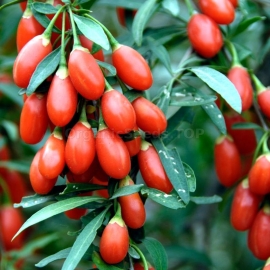 EXCLUSIVE
EXCLUSIVE





Organic Tibetan Goji Berry Seeds (Lycium barbarum)
-
Organic Tibetan Goji Berry / Lycium barbarum
Compact long-lived bushes bear plump, juicy, sweet red fruits bursting with vitamins and minerals, which are produced all summer long, right up to the first frosts.
These easy-to-grow, drought-tolerant tomato relatives will grow in any soil, are hardy down to -15c, and can produce 1-2 kg of fruit when only 2 years old! These have now been acknowledged as one of the main so-called 'superfruits', a marketing term referring to a fruit which combines exceptional nutrient richness and antioxidant with a pleasant taste. Also known as Wolf Berry, they have actually been established in England for centuries despite the recent upsurge in popularity.
Also known as: Chinese wolfberry, Chinese boxthorn, Himalayan goji, Tibetan goji, Barbary Matrimony Vine, Duke of Argyll's tea tree, Duke of Argyll's tea plant, Murali, Red Medlar or Matrimony Vine.
How to Grow
Plants grown from seed are similar in appearance to tomato seedlings at first. Seedlings and young plants are likely to be variable in appearance, and can be grown in a nursery until the following year, when they can be transplanted to the field. Dormant nursery stock should be planted in spring once danger of frost is past.
Mulching after planting with an organic mulch can keep down weeds, moderate root temperatures, and promote establishment. Irrigation is highly recommended especially during the establishment year, as the root system is fine and can easily dry out, and the fruit are prone to blossom end rot under conditions of low or uneven moisture. However, overwatering should be avoided. Plants should be spaced 3 to 5 feet apart within the row and at least 6 to 8 feet between rows, though wider between-row spacing may be needed to accommodate equipment.
